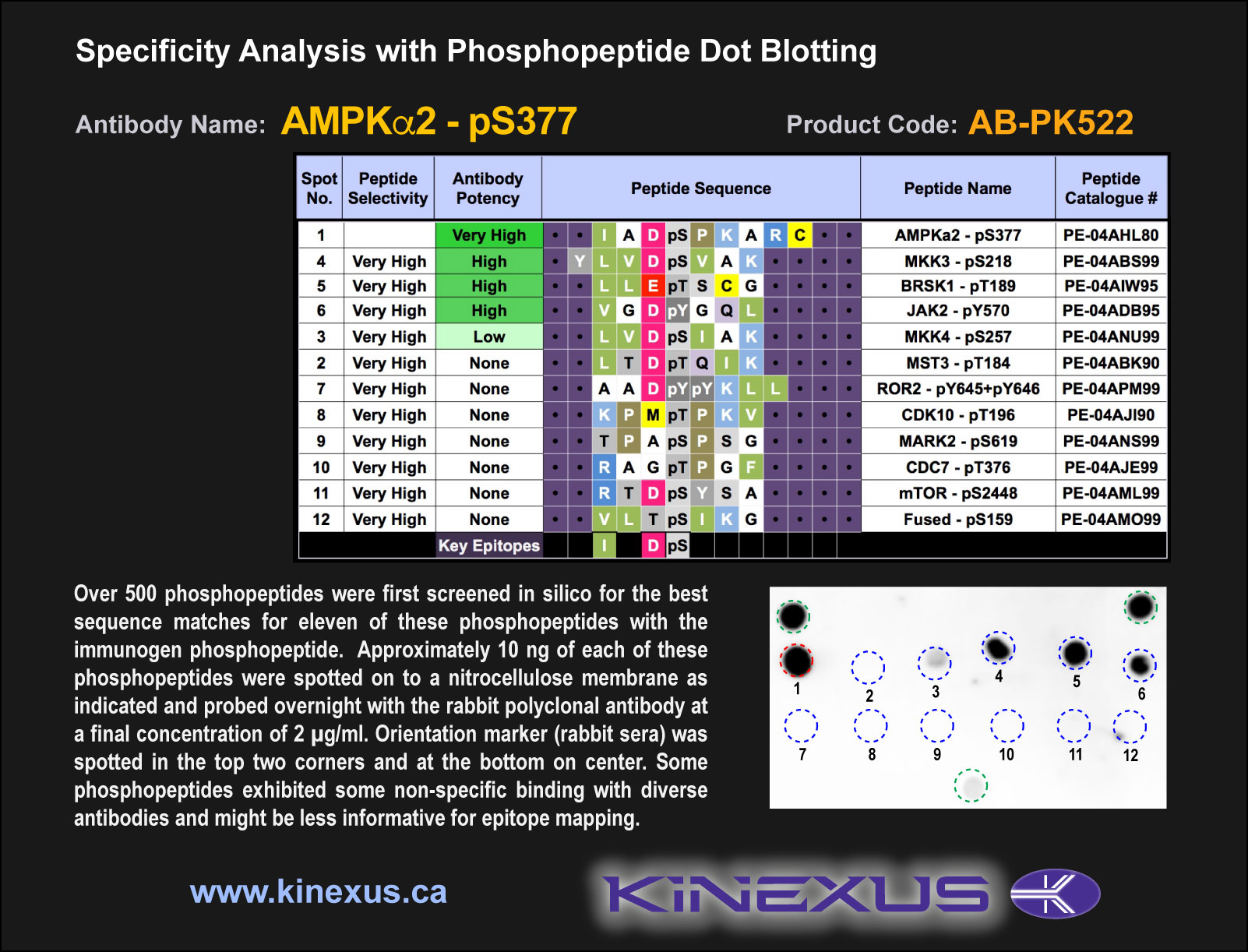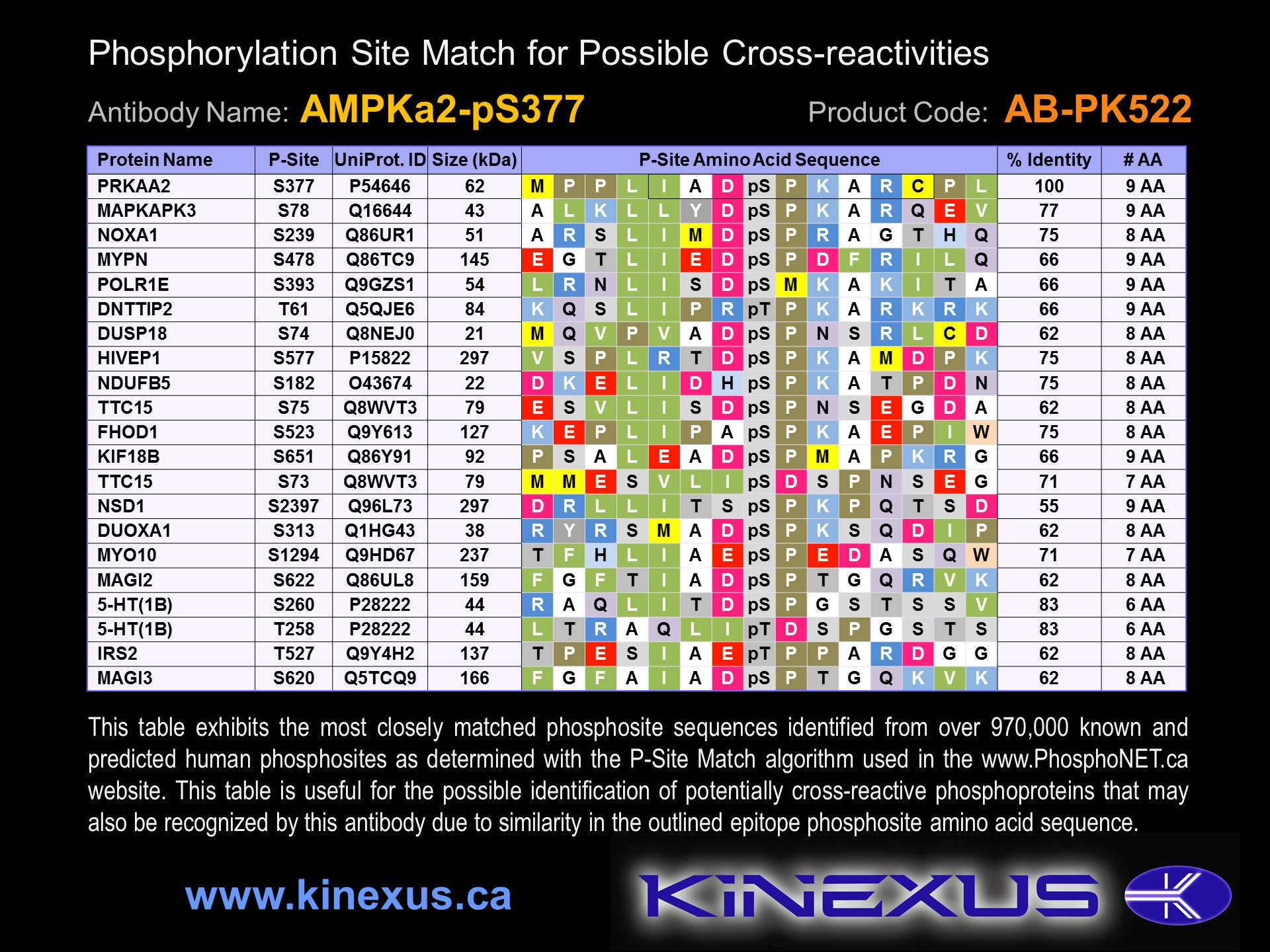Product Name: AMPKa2-pS377
Product Number: AB-PK522
| Size: | 25 µg | Price: | 89.00 | |
| $US |
Target Full Name: 5'-AMP-activated protein kinase catalytic subunit alpha-2
Target Alias: AAPK2; AMPK alpha-2 chain; Kinase AMPK-alpha2; AMPK2; PRKAA; PRKAA2 ENSG00000162409
Product Type Specific: Protein kinase phosphosite-specific antibody
Antibody Code: PK522
Antibody Target Type: Phosphosite-specific
Antibody Phosphosite: S377
Protein UniProt: P54646
Protein SigNET: P54646
Antibody Type: Polyclonal
Antibody Host Species: Rabbit
Target Alias: AAPK2; AMPK alpha-2 chain; Kinase AMPK-alpha2; AMPK2; PRKAA; PRKAA2 ENSG00000162409
Product Type Specific: Protein kinase phosphosite-specific antibody
Antibody Code: PK522
Antibody Target Type: Phosphosite-specific
Antibody Phosphosite: S377
Protein UniProt: P54646
Protein SigNET: P54646
Antibody Type: Polyclonal
Antibody Host Species: Rabbit
Antibody Immunogen Source: Human AMPKa2 (PRKAA2) sequence peptide Cat. No.: PE-04AHL80
Antibody Immunogen Sequence: IAD(pS)PKARC
Antibody Immunogen Description: Corresponds to amino acid residues I374 to C382; In the C-terminal half of the protein after the kinase catalytic domain. This is the major in vivo phosphorylation sites in AMPKa2.
Antibody Immunogen Sequence: IAD(pS)PKARC
Antibody Immunogen Description: Corresponds to amino acid residues I374 to C382; In the C-terminal half of the protein after the kinase catalytic domain. This is the major in vivo phosphorylation sites in AMPKa2.
Production Method: The immunizing peptide was produced by solid phase synthesis on a multipep peptide synthesizer and purified by reverse-phase hplc chromatography. Purity was assessed by analytical hplc and the amino acid sequence confirmed by mass spectrometry analysis. This peptide was coupled to KLH prior to immunization into rabbits. New Zealand White rabbits were subcutaneously injected with KLH-coupled immunizing peptide every 4 weeks for 4 months. The sera from these animals was applied onto an agarose column to which the immunogen peptide was thio-linked. Antibody was eluted from the column with 0.1 M glycine, pH 2.5. Subsequently, the antibody solution was neutralized to pH 7.0 with saturated Tris.This antibody was also subject to negative purification over phosphotyrosine-agarose.
Antibody Modification: Unconjugated. Contact KInexus if you are interest in having the antibody biotinylated or coupled with fluorescent dyes.
Antibody Modification: Unconjugated. Contact KInexus if you are interest in having the antibody biotinylated or coupled with fluorescent dyes.
Antibody Concentration: 1 mg/ml
Storage Buffer: Phosphate buffered saline pH 7.4, 0.05% Thimerasol
Storage Conditions: For long term storage, keep frozen at -40°C or lower. Stock solution can be kept at +4°C for more than 3 months. Avoid repeated freeze-thaw cycles.
Product Use: Western blotting | Antibody microarray
Antibody Dilution Recommended: 2 µg/ml for immunoblotting
Antibody Potency: Very strong immunoreactivity with immunogen peptide on dot blots.
Antibody Species Reactivity: Human
Antibody Positive Control: The observed molecular mass of the processed target protein on SDS-PAGE gels is reported to be around 60-65 kDa.
Storage Buffer: Phosphate buffered saline pH 7.4, 0.05% Thimerasol
Storage Conditions: For long term storage, keep frozen at -40°C or lower. Stock solution can be kept at +4°C for more than 3 months. Avoid repeated freeze-thaw cycles.
Product Use: Western blotting | Antibody microarray
Antibody Dilution Recommended: 2 µg/ml for immunoblotting
Antibody Potency: Very strong immunoreactivity with immunogen peptide on dot blots.
Antibody Species Reactivity: Human
Antibody Positive Control: The observed molecular mass of the processed target protein on SDS-PAGE gels is reported to be around 60-65 kDa.
Antibody Specificity: Medium
Antibody Cross Reactivity: Multiple cross-reactive proteins were detected in MCF7 cells, but A431 cells and HeLa cells and sea star oocytes showed no significant cross-reactivities.
Related Product 1: AMPKa2-pS377 blocking peptide
Related Product 2: AMPKa1-AKCD pan-specific antibody (Cat. No.: AB-NK259-1)
Related Product 3: AMPKa1-NT pan-specific antibody (Cat. No.: AB-NK259-2)
Related Product 4: AMPKa2-AKCD1 pan-specific antibody (Cat. No.: AB-NK260-2)
Related Product 5: AMPKSelectide - AMPKa1 (PRKAA1) protein kinase substrate peptide
Related Product 6: AMPKSubtide - AMPKa2 (PRKAA2) protein kinase substrate peptide
Antibody Cross Reactivity: Multiple cross-reactive proteins were detected in MCF7 cells, but A431 cells and HeLa cells and sea star oocytes showed no significant cross-reactivities.
Related Product 1: AMPKa2-pS377 blocking peptide
Related Product 2: AMPKa1-AKCD pan-specific antibody (Cat. No.: AB-NK259-1)
Related Product 3: AMPKa1-NT pan-specific antibody (Cat. No.: AB-NK259-2)
Related Product 4: AMPKa2-AKCD1 pan-specific antibody (Cat. No.: AB-NK260-2)
Related Product 5: AMPKSelectide - AMPKa1 (PRKAA1) protein kinase substrate peptide
Related Product 6: AMPKSubtide - AMPKa2 (PRKAA2) protein kinase substrate peptide
Related Product 7: AcCoACarbox (73-85) S77A, KinSub - Acetyl-Coenzyme A carboxylase alpha (H73-R85, mouse) peptide; AMPKA protein kinase substrate; SAMStide
Related Product 8: GSK3b (3-12) KinSub - Glycogen synthase kinase 3-beta (GSK3b) N-terminus (G3-E12, human) peptide; Akt protein kinase substrate peptide
Related Product 8: GSK3b (3-12) KinSub - Glycogen synthase kinase 3-beta (GSK3b) N-terminus (G3-E12, human) peptide; Akt protein kinase substrate peptide
Scientific Background: AMPKa2 (PRKAA2) is a protein-serine/threonine kinase of the CAMK group and CAMKL family. It is the catalytic subunit of AMP-activated protein kinase (AMPK),which is an energy sensor protein kinase that plays a key role in regulating cellular energy metabolism. In response to reduction of intracellular ATP levels, AMPK activates energy-producing pathways and inhibits energy-consuming processes: inhibits protein, carbohydrate and lipid biosynthesis, as well as cell growth and proliferation. AMPK acts via direct phosphorylation of metabolic enzymes, and by longer-term effects via phosphorylation of transcription regulators. It also acts as a regulator of cellular polarity by remodeling the actin cytoskeleton. Binding of AMP results in allosteric activation, inducing phosphorylation on T172 by STK11 in complex with STE20-related adapter-alpha (STRAD alpha) pseudo kinase and CAB39.It is also activated by phosphorylation by CAMKK2 triggered by a rise in intracellular calcium ions, without detectable changes in the AMP/ATP ratio. Defects in PRKAA2 are linked to Peutz-Jeghers Syndrome, which is a relatively rare autosomal dominant disease where benign polyps develop on the GI tract.
Figure 1. Epitope mapping of AMPKa2-pS377 antibody with similar phosphopeptides on dot blots.
Figure 2. Identification of phosphosites related to AMPKa2-pS377.
© Kinexus Bioinformatics Corporation 2017



